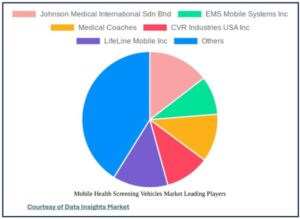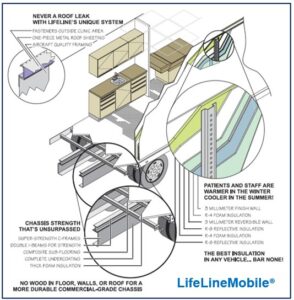Essential Attributes When Considering Mobile Health: A Guide for Hospitals – Part 2
Of the approximately 3,000 mobile health clinics nationwide, it’s estimated that over half are operated by hospital systems, universities, or health networks. These clinics deliver over 10 million patient visits annually, serving as a critical extension of hospital services and helping to bring care directly to communities that might otherwise struggle to access traditional healthcare facilities.
Mobile clinic’s healthcare affiliations vary:
- 33% are independent
- 24% are affiliated with a university
- 29% are part of a hospital or health care system

As healthcare organizations consider purchasing a mobile clinic, several essential attributes must be taken into account. It is critical to focus on vehicle fundamentals as well as the features and services that you wish to provide. For instance, a healthcare group may want to provide dental services, and a quality dental operatory needs heavy power dental chairs and delivery systems. In turn, this requires a vehicle capable of carrying this heavy equipment 50 weeks a year for thousands of miles. A retrofit passenger bus with a light-duty frame will not withstand these conditions in the long run, whereas a truck with a stronger frame can last for decades.
When making such a significant investment, it’s essential to focus on a durable vehicle that’s large enough to accommodate the attributes you need, while safely serving your patients and staff. For instance, larger vehicles with slide-outs offer flexibility and additional space required to do the job day-to-day and year-to-year.
- Trucks with tandem axles and four-slide outs are sized to allow dental, medical, or a combination of the two in one vehicle.
- Do not settle for light duty RV and bus based vehicles that may be between 19 and 26 feet long.
- If you require the capability of adding and removing large, portable equipment like ultrasound, self-contained dental delivery carts for evacuation, and an air compressor, make sure your mobile medical clinic selection has enough space to make those accommodations.
- Plan for inevitable changes in the future. For instance, if funding, grants, or community needs change, ensure you select a vehicle that can be retrofitted to accommodate changes in program focus.
- Opt for a vehicle that is built with commercial, hospital-grade durability, inside and out, to ensure years of service to your community.
With recent changes to CDL testing making acquiring a CDL license more achievable than ever, the value of the interior space in these heavy-duty mobile health clinics is unparalleled and has multiple benefits:
- A doctor, an assistant, and the equipment have the freedom to move around the room and the patient without restrictions. For instance:
- Two to three exam rooms, rather than a single exam room, allow for better patient flow. One patient can be prepped or changing, while the other exam room is being used for the exam. The hospital staff is the most expensive ongoing cost of the vehicle. Maximizing their time is essential to a successful and profitable program.
- Four-handed (two-person – dentist and assistant) dentistry requires 60 inches of space around the head of the patient.
- A standard medical exam typically requires access to three sides of the patient.
- Moving diagnostic equipment, such as ultrasounds, into place while still having room for the patient exam is made easy.
- There is room for other procedures, such as vitals (height and weight) and blood draw.
- An additional storage supply area is available to help improve patient flow. This allows the medical team to see more patients during a service day.
- Movement around the vehicle can be planned for ADA accessibility, whether your mobile clinic has a wheelchair lift onboard or not.
- Key dimensions that should be in place on an ADA vehicle:
- 60” turnaround space for a wheelchair
- 32” door openings
- 48” latch approaches to doors
- 36” hallways
- ADA spaces provide essential capacity for several purposes:
- Multiple people (doctor/nurse, patient, guardian/companion) can comfortably be in the same room at the same time and easily move around the exam space.
 Ample room for performing multiple services in the same space -intake, waiting, vitals, and lab area in the public area of the vehicle.
Ample room for performing multiple services in the same space -intake, waiting, vitals, and lab area in the public area of the vehicle.
- Room for extra consultation space, maximizing confidential exam room usage.
- Understand the need for extra strength of chassis to support equipment, especially with larger vehicles that make multiple trips or operate in more rugged terrain, such as hilly regions or uneven roads.
- Smaller RVs are lighter weight and built to a vacation quality. They are built with lightweight materials, from the chassis frame to the flooring, cabinetry, and walls. This is not a suitable recipe for a vehicle that you intend to last for decades and use 50 weeks out of the year. Lighter construction results in faster metal fatigue, bending frames, and welds breaking, as well as other reliability issues with the vehicle.
- Heavier equipment, such as audio booths, power dental chairs, power exam tables, mammography, x-ray, and more, requires a strong floor and wall frames to support them. If your vehicle is not robust enough, the bouncing and vibration over the road, compounded year after year, will cause metal fatigue, bent and cracked frames, as well as damage to valuable equipment. And any of this jeopardizes patient and staff safety. Imagine a power dental chair breaking through the floor with a patient in it.
- Slide-out walls are great for providing extra space, but they also need a strong frame to hold the slide-outs, stay in square, and support the cantilevered weight of the rooms when they are deployed. In addition, the weight of the slide-out when stored and bouncing down the road, hitting potholes, and twisting over ramps, turns, and other adverse conditions can torque the frame and body. Lightweight vehicle bodies cannot hold up to these stresses for very long.
15 Things to Consider When Planning Your Mobile Healthcare Program
- What services are already available in your targeted program area?
- What are the current provider-patient ratios?
- How many underserved people are in that area?
- What and where are the coverage gaps?
- What are the barriers to healthcare for patients?
- How far do patients have to travel for care?
- What are the maximum and minimum number of patients you expect to serve?
- Are there cultural or language issues involved?
- Are there concentrations of homeless or migrant people who need care where they work or live?
- Can you… or should you… partner with another organization to get the work accomplished?
- What other uses can your mobile unit serve if it is not fully utilized right away?
- What are your anticipated start-up costs?
- What are the ongoing operating costs?
- Can you estimate the cost of not establishing your program now, in terms of steadily rising equipment costs?
- What is the cost of not serving families who are going without care?
Conclusion: Strategic Value of Mobile Health Clinics for Hospital Systems
Mobile health clinics are a powerful extension of hospital services, enabling systems to expand access to care, particularly in underserved and remote communities. By bringing care directly to patients, these clinics support population health goals, improve preventive care delivery, and help reduce avoidable emergency department visits.
Beyond service delivery, mobile clinics foster community trust and engagement. They provide leadership with direct insight into local health needs, informing more responsive and equitable care strategies across the system.
Investing in world-class mobile units unlocks even greater potential. These heavy-duty vehicles accommodate more comprehensive clinical services, including diagnostic equipment such as X-ray machines, multiple dental stations, dedicated treatment areas, and expanded care teams, enabling hospitals to deliver higher-acuity services in the field. The increased space and mobility also support broader geographic reach, helping the system extend its mission of care to rural and hard-to-reach populations.
Mobile health clinics are essential for hospitals as they improve access to care in underserved communities and enhance preventative services. These mobile doctors’ offices foster community trust with the hospital, enabling the organization to gain a deeper understanding of local health needs and deliver more effective healthcare.
For hospital leadership focused on improving outcomes, closing care gaps, and strengthening community relationships, mobile health clinics are a scalable, high-impact solution that aligns with system-wide strategic goals.


 Ample room for performing multiple services in the same space -intake, waiting, vitals, and lab area in the public area of the vehicle.
Ample room for performing multiple services in the same space -intake, waiting, vitals, and lab area in the public area of the vehicle.